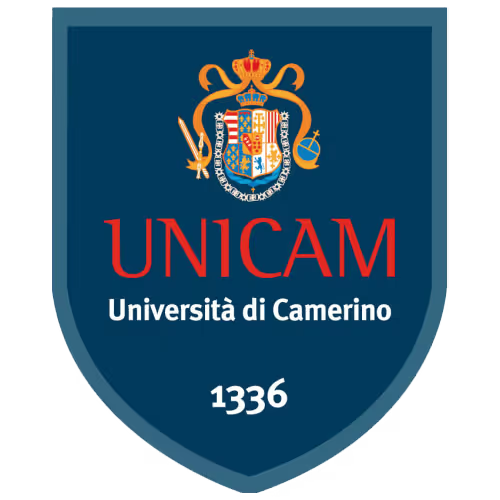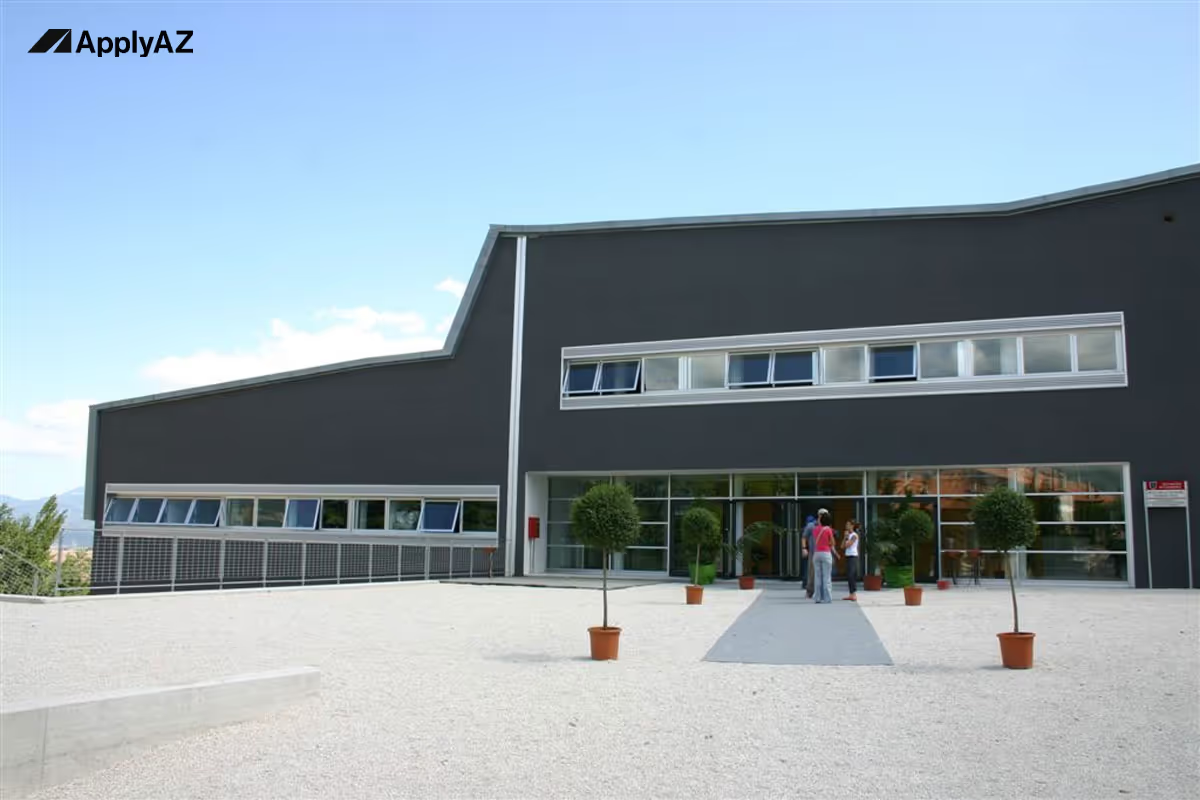Heading
Heading








University of Camerino
A historic campus with modern research ambitions
Founded in 1336, the University of Camerino is one of Europe’s oldest public institutions. Despite its age, the university keeps pace with global innovation through five specialised schools: Architecture and Design, Biosciences and Veterinary Medicine, Law, Pharmacy, and Science and Technology. International rankings often highlight its research impact in chemistry and computer science, while the teaching environment earns high student‑satisfaction scores. Several master’s degrees now run fully in English, adding to the growing list of English‑taught programs in Italy and giving you the chance to study in Italy in English while paying regulated state fees.
Academic highlights
- Chemistry and Advanced Materials laboratories recognised by European research councils.
- Computer Science department leading Horizon projects on cybersecurity and artificial intelligence.
- Veterinary Medicine hospital offering hands‑on clinical rotations with small and large animals.
- Architecture school nestled in a UNESCO‑listed region, perfect for heritage‑restoration studies.
Living and learning in Camerino
Camerino is a small medieval town in the Marche region. Its compact size means lecture halls, dorms, cafés, and sports facilities all sit within a fifteen‑minute walk. With roughly 6,000 residents and 8,000 students, the local economy welcomes student life. Rents for shared flats average €200–€250 per month, and university cafeterias serve balanced meals for under €4. The Apennine setting keeps summers warm (about 28 °C) and winters cool but sunny (around 4 °C), ideal for hiking or skiing between study blocks. Buses link the town centre to railway hubs, and a discounted student pass covers regional travel.
Cultural events—classical concerts in Renaissance halls, food festivals celebrating truffles and olives, and weekend language exchanges—make it easy to integrate. Because classes are in English, international students quickly build mixed friendship groups, then pick up conversational Italian during everyday errands.
Job prospects and internships
While Camerino itself is small, its network of partnerships spans the Marche manufacturing belt and national research centres. Key sectors include:
- Pharmaceuticals and biotech – regional plants host internships for pharmacy and chemistry students.
- Agri‑food technology – nearby companies refine food‑quality analytics and sustainable packaging.
- Advanced manufacturing – robotics and composite‑material firms collaborate with engineering labs on Industry 4.0 projects.
- Digital services – local start‑ups use cloud and AI solutions, offering roles for computer‑science graduates.
Internship agreements allow you to earn thesis credits and apply classroom theory to real problems. Many positions accept English as the working language and pay modest stipends, easing living costs. After graduation, alumni find roles across Italy and wider Europe, helped by the university’s career office and Erasmus+ research networks.
Funding and scholarships
Being part of public Italian universities, Camerino keeps tuition predictable—generally €900–€2,000 a year depending on household income. International applicants can compete for the DSU grant, which may waive fees entirely, provide rent support, and add a yearly stipend of up to €7,000. Merit scholarships for high GPA or language scores further reduce expenses, making the overall package competitive with tuition‑free universities Italy references.
Why choose Camerino
- Intimate learning: small cohorts mean professors know your name and guide your research closely.
- Cost advantage: affordable housing, DSU grant opportunities, and low campus fees.
- Research access: modern labs open to master’s students from the first semester.
- Lifestyle balance: safe town, clean air, mountain sports, and rich cultural heritage.
Finish your classes on Friday, hike the Sibillini peaks on Saturday, and present your polymer‑science poster at a European conference on Monday—that’s the Camerino rhythm.
In two minutes we’ll confirm whether you meet the basic entry rules for tuition-free, English-taught degrees in Italy. We’ll then quickly see if we still have space for you this month. If so, you’ll get a personalised offer. Accept it, and our experts hand-craft a shortlist of majors that fit your grades, goals, and career plans. Upload your documents once; we submit every university and scholarship application, line up multiple admission letters, and guide you through the visa process—backed by our admission-and-scholarship guarantee.
Chemistry and Advanced Chemical Methodologies (LM‑54) at University of Camerino
1. Why this English‑medium chemistry programme deserves attention
Modern chemists must master nano‑scale design, ultra‑fast analysis, and sustainable manufacturing. English‑taught programs in Italy now offer that breadth while keeping tuition realistic. By choosing to study in Italy in English on the Chemistry & Advanced Chemical Methodologies LM‑54, you join centuries of Italian scientific tradition yet pay the regulated fees of public Italian universities. Layer the DSU grant onto merit awards and your outlay can rival packages from tuition‑free universities Italy promotes—without sacrificing research firepower.
The department at University of Camerino enjoys global citations for green catalysis, pharmaceutical crystallography, and materials chemistry. Small cohorts—rarely above 25 students—mean professors critique your NMR spectra personally, and lab slots never feel crowded. Industrial partners fund real projects, so your dissertation data can feed patent filings or peer‑reviewed papers. By graduation, you will handle advanced instruments confidently, code chem‑informatics pipelines, and pitch innovations fluently in English—skills employers and PhD committees both prize.
2. Programme blueprint: 120 ECTS over four robust semesters
Semester 1 – core molecular insight
- Advanced Organic Synthesis (9 ECTS) – Retrosynthetic logic, asymmetric catalysis, and flow chemistry; weekly labs run continuous‑flow cross‑couplings under microreactor conditions.
- Spectroscopic Characterisation (9 ECTS) – NMR (1D/2D), FT‑IR, UV‑Vis, and mass spectrometry; problem sets assign spectral deconvolution of natural‑product extracts.
- Computational Chemistry (6 ECTS) – Density‑functional theory, molecular dynamics, and QM/MM hybrids using Gaussian and ORCA on the university cluster.
Semester 2 – tools for green and functional chemistry
- Catalysis and Sustainable Processes (9 ECTS) – Heterogeneous catalysts, photocatalysis, and life‑cycle assessment; students compare E‑factor metrics of batch vs flow nitration.
- Materials Chemistry (6 ECTS) – Polymer design, MOFs (metal–organic frameworks), perovskites; lab projects fabricate thin‑film solar absorbers.
- Analytical Method Validation (6 ECTS) – Calibration, precision, accuracy, and regulatory standards; tasks include developing an HPLC assay for antioxidant quantitation.
- Elective A (6 ECTS) – pick Medicinal Chemistry, Supramolecular Design, or Environmental Monitoring.
Semester 3 – applications and data fluency
- Cheminformatics and Data Mining (6 ECTS) – SMILES, QSAR, machine learning; Python notebooks build toxicity‑prediction models.
- Industrial Quality and Regulatory Affairs (6 ECTS) – GMP, REACH, ICH guidelines; case study audits mock documentation for an API plant.
- Elective B (6 ECTS) – choices include Nanochemistry, Solid‑State NMR, or Electrochemical Energy Storage.
- Research Project Planning (6 ECTS) – literature review, experimental design, and grant writing; each student drafts a proposal that becomes the thesis backbone.
Semester 4 – immersion in research
- Research Internship (18 ECTS) – 450 hours in a university lab or external company; deliverables: lab notebook, progress seminar, and patent/paper outline.
- Master’s Thesis (30 ECTS) – typically 6–8 months of experiments or simulations culminating in a defence and journal‑style manuscript.
Total: 120 ECTS, fully taught and assessed in English.
3. Learning methodology: flipped content, sprint labs, rapid feedback
Professors upload concise video capsules and reading packets one week ahead. Timetabled meetings pivot to data interpretation, spectral troubleshooting, and white‑board mechanisms. Lab work follows a sprint rhythm:
- Planning day – define reagents, safety measures, and success metrics.
- Execution window – complete synthesis or analysis by mid‑week.
- Stand‑up review – five‑minute peer presentations of yields, spectra, and purification steps.
- Reflection – document modifications, green metrics, and future iterations.
Weekly quizzes in Moodle track retention, and coding assignments auto‑grade within minutes, so misconceptions halt early.
4. Research infrastructure: industry‑grade kit for small‑cohort access
- 400 MHz & 600 MHz NMR spectrometers with cryoprobes for ultralow concentration samples.
- High‑Resolution Mass Spectrometry (Orbitrap and TOF) coupled to UHPLC systems.
- Glove box suite for air‑sensitive organometallic routes.
- Pilot‑scale flow reactor (10 L h⁻¹) to test green processing.
- Surface and materials labs – BET, AFM, and PXRD for porosity and crystallography.
- HPC cluster – 10 000 CPU cores and 200 GPUs; Gaussian, VASP, GROMACS pre‑installed.
Booking uses an English web dashboard. With low student–instrument ratios, wait times rarely exceed 24 hours.
5. Internship destinations: bridging campus to enterprise
Recent placements include:
- International pharma – crystal‑form screening for new antiviral candidates.
- Green‑chem start‑up – scale‑up of photocatalytic wastewater treatment.
- Polymer additive supplier – stability studies on biodegradable packaging.
- National research council – DFT prediction of MOF gas‑adsorption selectivity.
Internship supervisors and faculty co‑author conference posters—giving you early citations.
6. Funding landscape: DSU grant plus layered scholarships
6.1 DSU grant specifics
- Eligibility: family income within regional thresholds; open to EU and non‑EU students.
- Package: tuition waiver, subsidised housing or rent stipend, meal vouchers, and up to €7 000 cash.
- Renewal: complete 30 ECTS per academic year with passing grades.
6.2 Additional scholarships for international students in Italy
- Merit fee reductions for GPAs ≥ 3.5/4.0 or GRE Chemistry ≥ 70th percentile.
- Lab assistantships—paid shifts supervising under‑graduate practicals.
- Erasmus+ mobility grants, e.g., a term researching photochemistry in Germany.
- Industrial bursaries funding sustainable‑chemistry theses (average €2 000–€3 000).
Combine these layers, and total cost may align with select tuition‑free universities Italy advertises, yet you retain state‑of‑the‑art facilities and personal mentorship.
7. Admission checklist and ApplyAZ support
- Bachelor’s in chemistry or related (180 ECTS) including organic, inorganic, analytical, and physical chemistry.
- English proof – IELTS 6.5, TOEFL 90, or proof of prior English‑medium degree.
- Document package – transcripts, passport, CV, and Motivation Letter.
- Online interview – 20 minutes on lab safety, reaction design, and career goals.
8. Unique selling points recapped
- Entirely English‑taught inside a historic yet modern Italian chemistry hub.
- Advanced instruments shared by small cohorts, ensuring abundant hands‑on time.
- Curriculum blending synthesis, computation, analytics, and green metrics.
- DSU grant and merit funds shrink costs towards tuition‑free standards.
- High placement into pharma, materials, and doctoral research.
- Mediterranean setting fosters quality of life and focused study (details beyond article scope).
Ready for this programme?
If you qualify and we still have a spot this month, we’ll reserve your place with ApplyAZ. Our team will tailor a set of best-fit majors—including this course—and handle every form and deadline for you. One upload, many applications, guaranteed offers, DSU grant support, and visa coaching: that’s the ApplyAZ promise. Start now and secure your spot before this month’s intake fills up.

They Began right where you are










